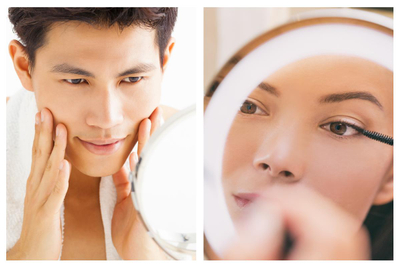
Western fashionistas may have been applying innovative Korean skincare products for years, but Asian consumers have come a little later to the party. According to research company Nielsen, six out of 10 consumers in China, Hong Kong, Taiwan and Singapore only ‘discovered’ Korean beauty brands in the past two years.
South Korea is one of the world’s fastest-growing beauty and personal care markets, posting year-on-year growth of 5.8 per cent, compared to just 2.1 per cent for the UK and 3.9 per cent for the US, according to Mintel findings.
“The total value of sales of skincare and colour cosmetics in South Korea reached US$6.2 billion in 2014,” says Minji Kim, a senior analyst for Euromonitor.
But this is not easy money. Every brand faces fierce competition to win customers. From Korea’s largest beauty brand Amore Pacific, whose Cushion Compact sold more than 1.3 million units overseas in 2013, to startup mobile ecommerce site Memebox with a bespoke cosmetics line, brands are undoubtedly working hard to stand out.
Young women aged 18 to 29 are the key demographic responsible for the growing interest in Korean products in China, Hong Kong, Taiwan and Singapore, says Yvonne Lum, VP of consumer insights at Nielsen Hong Kong.
“Korean beauty brands are benefiting from the popularity of K-Pop and Korean TV series,” she says. “Most brands are operating in between the mass and prestige market segments.”
The popularity of Korea as a travel destination—particularly among the growing Chinese middle-class—has also helped brands like Innisfree and It’s Skin, says Julien Lapka, managing director of brand consultancy Flamingo Shanghai.
But while Korean brands are gaining in popularity across the board, consumer loyalty differs between markets. Demand is relatively stronger in China, Singapore and Hong Kong, but Taiwanese consumers have a soft spot for Japanese brands.

Four years ago, Korean cosmetics brand Dr Jart+ saw runaway international success with its BB (Beauty Balm) cream, which is now available in 15 countries. According to John Kim of parent company Have&Be, the skincare product was carefully branded to win younger fans.
“Usually dermatological brands are boring and conservative. Our brand is very fresh and young.”
Kim explains that his company worked with an American marketing team to create an eye-catching global concept. However, he emphasises that product quality remains paramount to success.
Korean manufacturers have been developing innovative and unusual ingredients, such as snail slime, bee venom and snake venom extract, in order to increase market share in a competitive situation.
“They are trying to expand distribution channels beyond physical stores and are active in new product development targeting niche consumers,” says Euromonitor’s Kim.
But Western brands are cottoning on to the fun factor. Last year L’Oréal acquired Magic Holdings, whose MG facial mask brand is an industry leader in China, with 26.4 per cent market share. Other up-and-coming brands to watch include Too Cool for School, Clio and Iope. “They focus on pleasure in use. So there’s a new package every few months, and it becomes a fun impulse buy,” says Lapka.
EXPERT OPINION
Consumers want innovative, impactful products
Alicia Yoon, CEO, Peach & Lily
 Over the last few years, the South Korean cosmetic industry has grown rapidly. The Korean consumer is very demanding and this has created a hyper-competitive market. The quality of Korean beauty products is driven by the exacting and unparalleled standards in Korean culture of what it means to have flawless skin.
Over the last few years, the South Korean cosmetic industry has grown rapidly. The Korean consumer is very demanding and this has created a hyper-competitive market. The quality of Korean beauty products is driven by the exacting and unparalleled standards in Korean culture of what it means to have flawless skin.
Consumers also want every product to be more innovative and more impactful. As a result, there is a very rapid pace of product development. Companies have become adept at developing amazing textures, scents and packaging—all at an affordable price point.
The growing export market has also allowed for further innovation. Dollars are driven back into beauty research and development, which results in new products being launched at a dizzying rate. These products then catch on globally.
Peach and Lily was launched three years ago. In the beginning, all the high-quality brands that I wanted to carry didn’t want to work with us since we were a new company. It took five months of persistence and continuous pitching to secure the ones I thought were the very best.
My key criteria is that the brands need to have a fresh take on beauty, as well as being top quality. If the brand is known for a gentle, glycerin-based moisturiser, that’s not that interesting to us because brands like Neutrogena already offer that in the US.
We want to offer something novel; a new kind of ingredient, better formulation, packaging or applicator, or perhaps a new texture or scent.
You might also like:
- Iope 'proves' you can make your face shiny even while weightless
- Asian shades of skin care
- Chinese loyalty to Korean beauty brands yet to be proven despite K-Pop craze
- Chinese cosmetics brand calls on star power for run at premium market



.jpg&h=334&w=500&q=100&v=20250320&c=1)

.jpg&h=334&w=500&q=100&v=20250320&c=1)
.jpg&h=334&w=500&q=100&v=20250320&c=1)
.jpeg&h=334&w=500&q=100&v=20250320&c=1)

.jpg&h=334&w=500&q=100&v=20250320&c=1)

.jpg&h=334&w=500&q=100&v=20250320&c=1)

.jpg&h=268&w=401&q=100&v=20250320&c=1)
+1.jpg&h=268&w=401&q=100&v=20250320&c=1)

.jpg&h=268&w=401&q=100&v=20250320&c=1)

.jpg&h=268&w=401&q=100&v=20250320&c=1)
.jpg&h=268&w=401&q=100&v=20250320&c=1)